The Power of Mapping
Maps and models help us see and visualize all sorts of concepts. To get our hands and heads around a topic or a complex system as well as ideas and simple systems. We can model conceptual ideas, real ecosystems, objects and interactions. To help understand the boundaries of a topic or the landscape of a system we make models to visualize the unseen. When you just start out, it’s good to make diagrams and maps that explore those boundaries and to capture all the potential elements, actors, agents, and components, found within a system or a topic.
Here are three types of maps that can help your get started when trying to get your arms around what a topic or system boundary should be. The mind map, the cluster map and the concept map are three great starter maps and each informs the next to help you understand a topic or system. By making these diagrams we can determine what is in or out, what elements or actors we need to pay attention to and we can start to see relationships between the concepts of a topic or system. These diagrams won’t explain causes and effects or WHERE you need to pay attention in order to make transformation (that’s another series of models) but they will give you a sense of the actors, elements, components, and the scope to then move to the next level of understanding.
Start with the mind map to capture everything you can think of related to the topic or idea, then move to a cluster map to help organize the ideas into meaningful groupings and start fleshing out relationships and then to do a concept map to help further understand the relationships between the ideas, actors and elements, and to refine the important threads in the system or topic.
The Mind Map
Many people have experience making mind maps and this is one of the easiest to get your head around. We do them when we brainstorm and its a good way to try and pull out of our heads and our research absolutely everything we can think of about a topic. It also allows us to free associate and to rabbit hole without negative consequences. Mind maps are good thinking tools for ourselves and our teams. It’s important to start quickly and be free with your thinking without censorship.
Making a mind map involves placing your central idea or topic in the center of the paper and writing down everything you can that comes to mind from that central topic. List the subtopics around the main topic and use these to stimulate your brainstorming down that subtopic. Moving out from the center, write down ideas and related words one after the other in a train of thought until it is exhausted. Place a circle or oval around each idea and connect the terms with a line. This isn’t required but I find it easier to follow the paths when the terms are separated from the connecting lines with a bounding shape.
The key to mind maps is that each arm off the center radiates out, getting farther and farther away from the central topic. Most ideas won’t connect from one leg of the diagram to another leg of the diagram but will be discrete trains of thoughts and in many cases, the outer ideas and concepts have absolutely nothing to do with the starting idea or with the concepts or ideas at the end of the other arms. That’s ok. Along the outer edges are the places you may find new ideas or elements or actors you may not have realized could be relevant to consider.
Questions to ask yourself as you move down an idea path include what, where, when, why, how and who, as related to the central topic.
The key with Mind Maps is to go back and layer in new ideas and connections to create a richer landscape if concepts. This will take a few passes to capture everything.
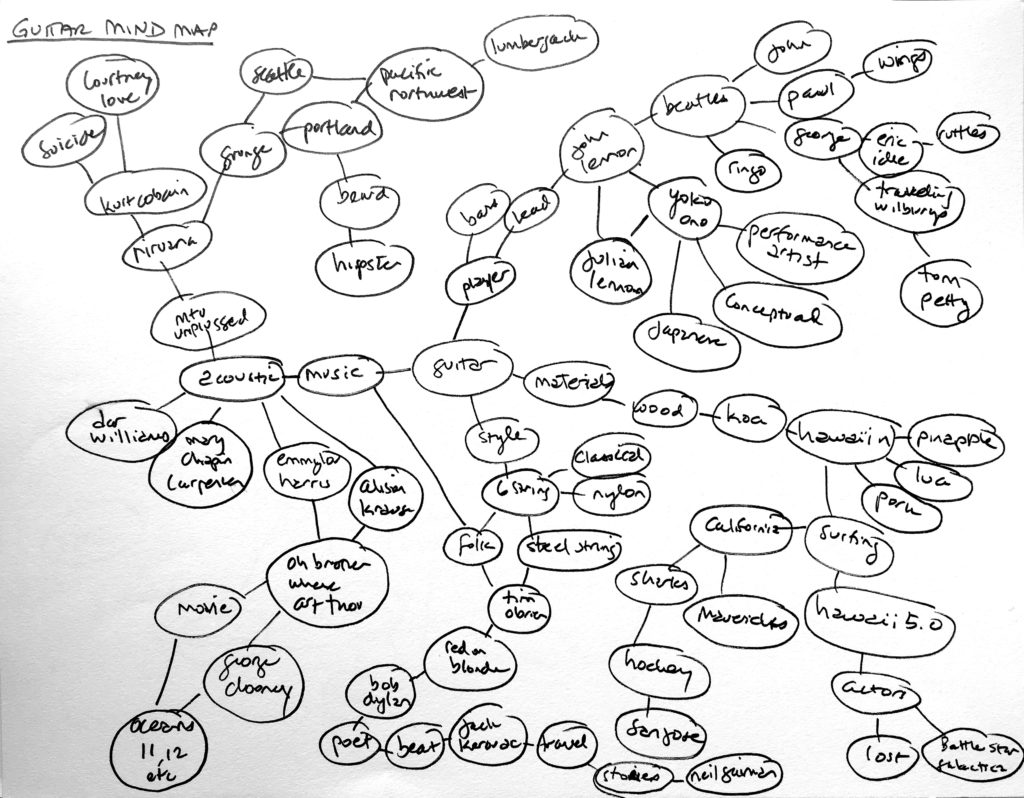
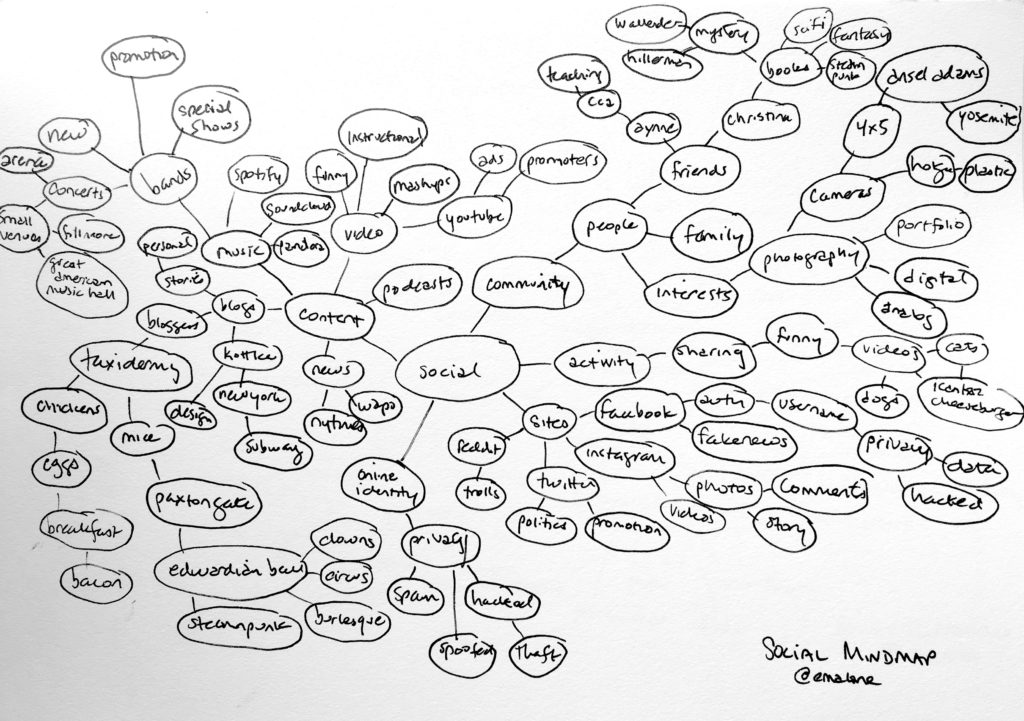
Other great resources for understanding Mind maps: https://www.informationtamers.com/WikIT/index.php?title=How_to_make_a_mind_map
A deeper look at how to make mind maps: http://www.fastefoundation.org/publications/mind_mapping.pdf
The Cluster Map
The cluster map helps you organize your concepts into groupings and to start to see relationships between those clusters and your central topic. Visually, the cluster map looks similar to the mind map, but the difference between the two is that the content in a cluster map is all related to the central idea and is organized around sub-topics. The cluster map forces you to group ideas and terms together that are related along each arm of the diagram. Additionally, concepts may be connected across the radiating arms.
A cluster map can be made to help organize ideas, actors, agents, elements or components seen in a system or simply to help organizing ideas for a talk, essay or other writings. It is a visual outline with no hierarchy yet. The cluster map can aid you or your team in determining which areas are important to understand or drill deeper into and can provide the first stage of thinking about a system’s architecture.
Making the cluster map starts the same way as the mind map. Put your main idea in the center of your page. Around the idea, place the next closely related sub-topics exploring elements, agents, actors, nodes, components. Thinking about each of these sub-ideas, brainstorm all the related ideas and place them on the map going out from the central idea. Tease out non-obvious parts of the system and draw connections and relationships between the elements. If some words are related to others or are parallel, place these on the same level out from the center. As you move further out from the center, your ideas and topic may be several levels out from the sub-topics or main idea but unlike the mind map, they are all still related to the central concept.
Make your cluster map after you make the mind map, and use the mind map as a reference to make sure you capture all the related ideas. Once you have exhausted all the topics, components and elements, look at where there might be relationships across clusters and draw those connecting lines.
The final map may look more like a network map, depending on how related sub-topics are, than a mind map which may look more random and less organized.
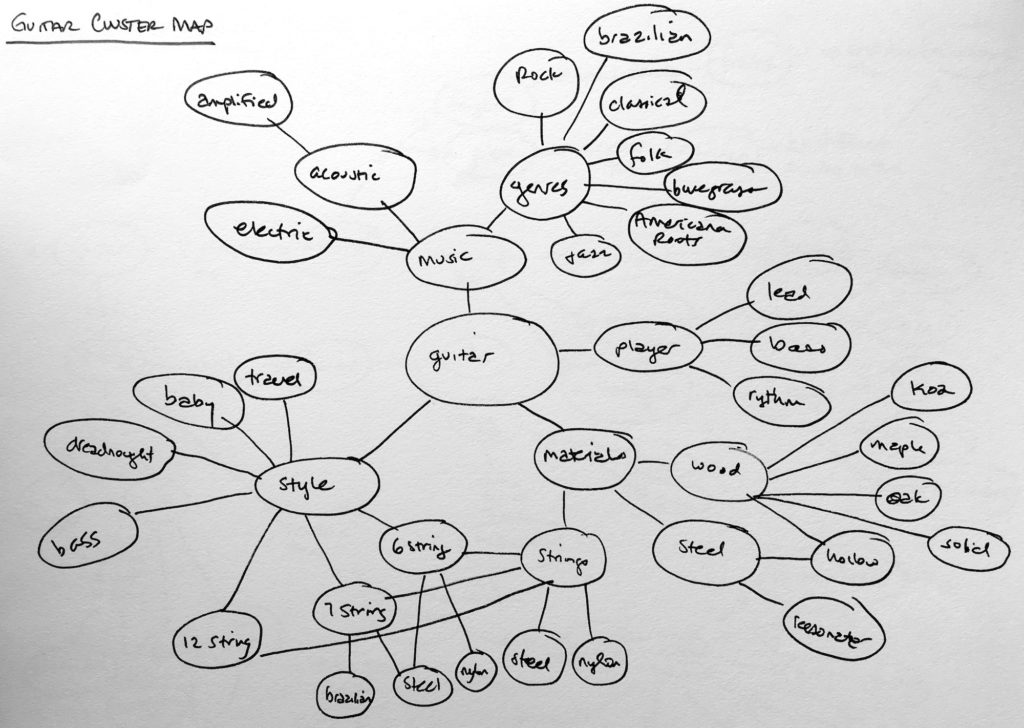
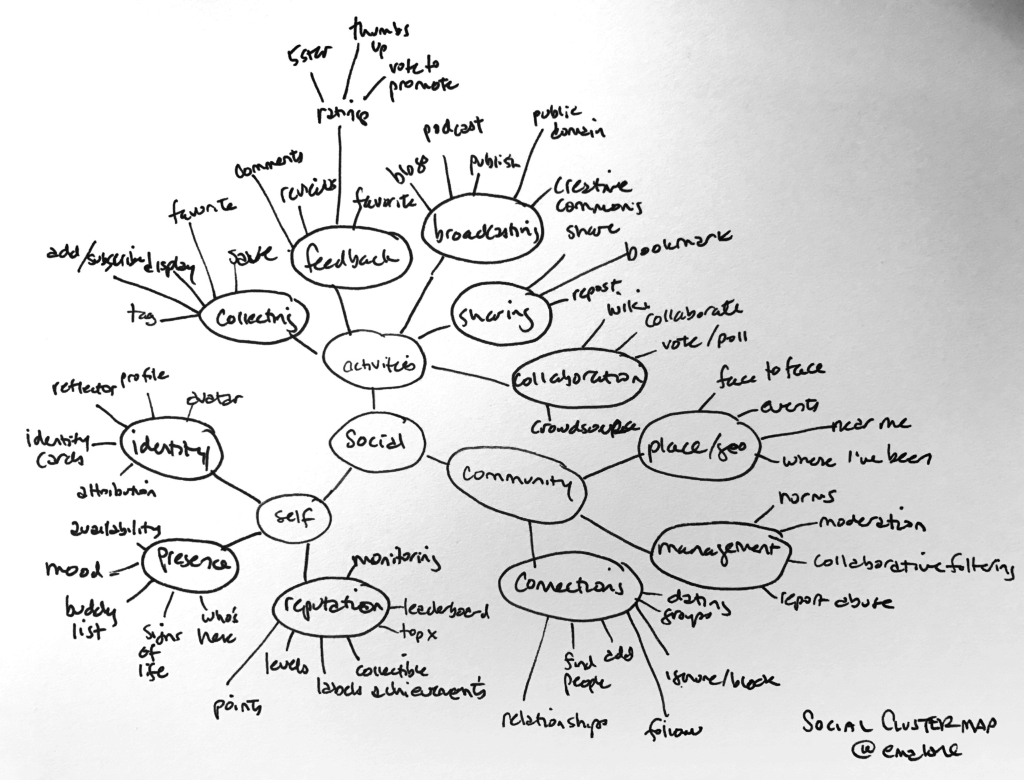
Other great resources for understanding Cluster maps: https://en.wikipedia.org/wiki/Cluster_diagram
The Concept Map
The concept map, takes the elements, agents, actors and components fleshed out in the cluster map and organizes the ideas into a meaningful order that clearly articulates relationships between each item.
A concept map looks at the elements, agents, actors and components as nouns and the way they are related or connected as the verbs.
A well done concept map can be read across, down and diagonally in the form of a sentences or a story that explains a train of concepts and their relationships to each other and the whole.
To start a concept map, place the main idea at the top left of your page. Working to the right, look at what that item contains, what it uses, how it is related to, or is part of the next item. The verbs that generally show up in a concept map may include things like—which includes, is part of, can be, is, enabled by, with, should be, defined by, with the help of, contains, have, use, behaving as, represented by, to, called, a type of, etc.
Using the cluster map as a guide for related items, work your way across exploring and completing a single coherent idea. Then from each of those main concepts (noun), work down or diagonally creating new ideas, exploring the nouns from your cluster map and the verbs that join them together.
Each idea, agent, actor, component or element is placed in an oval. The ovals are connected by lines and the verbs sit on the lines between the concepts, connecting them and giving them context.
The concept map shows relationships between these ideas and between the threads through the connections and can help you or your team understand all the factors in play within a system. When determining where to pay attention, what things to build or where to make change, having an understanding of these relationships can help prioritize or group priorities together. Because the concepts are related and connected, we can see what might happen if an element or actor is changed or is missing.
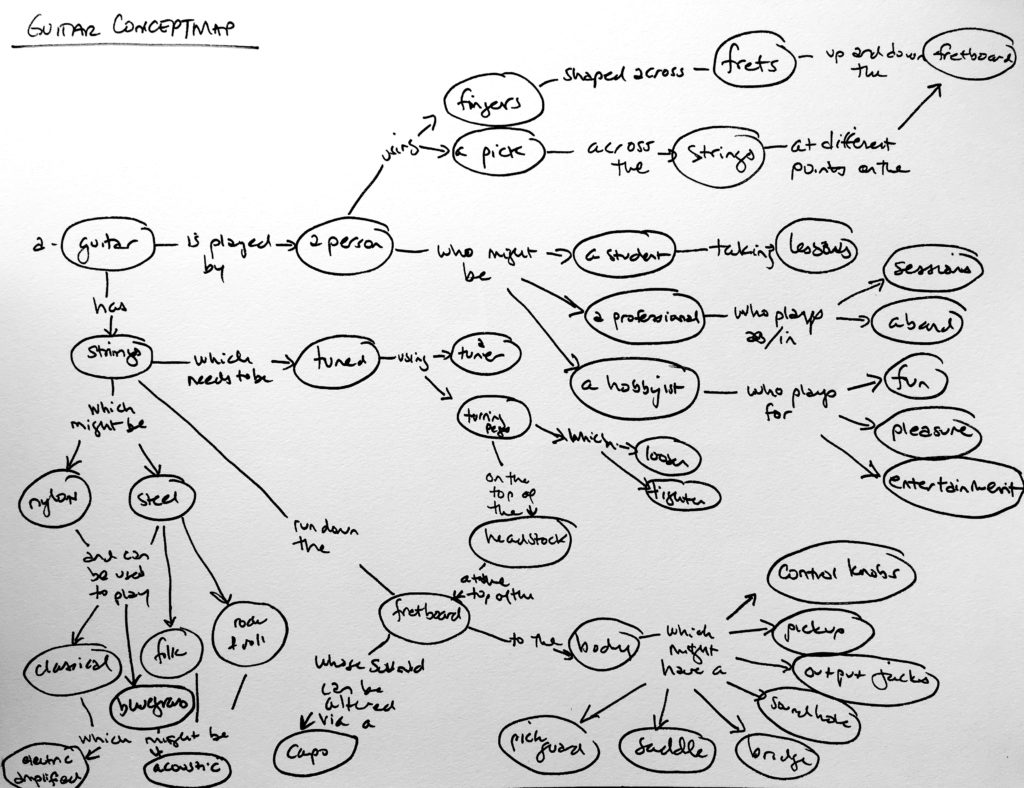
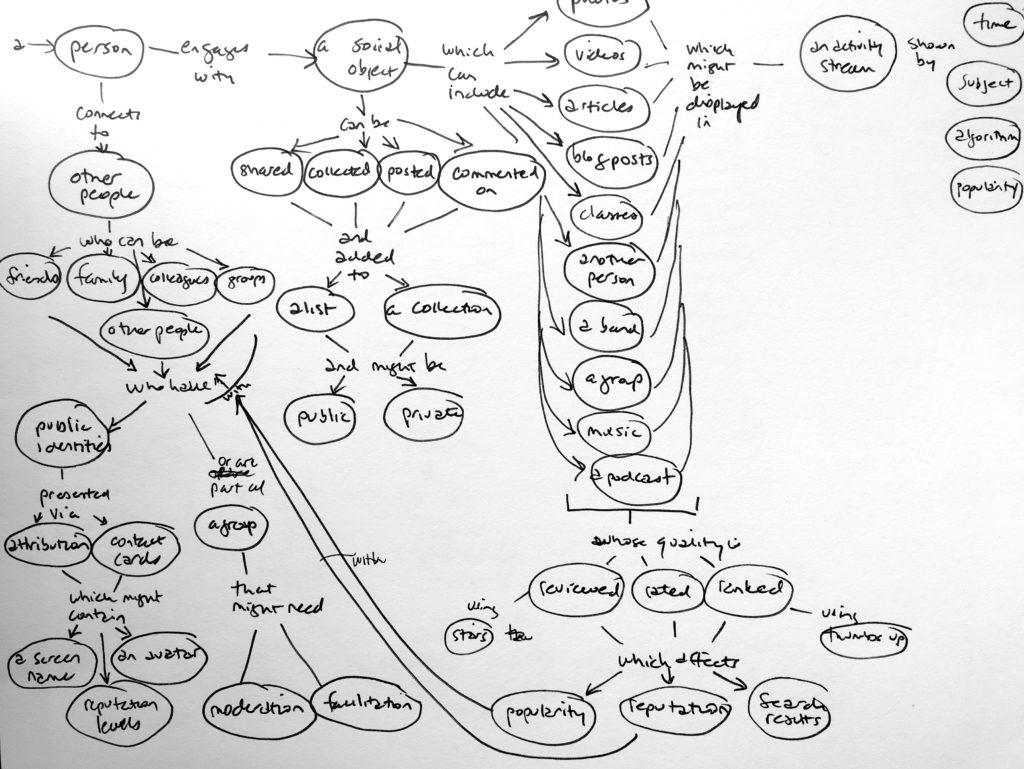
Other great resources for understanding Concept maps: http://www.dubberly.com/concept-maps/creating-concept-maps.html
Conclusion
Mapping is a powerful tool that can be done by anyone and are great tools for brainstorming, coming to group consensus and for developing an agreed upon vocabulary. Starting with Mind maps to inform a Cluster map which then informs a Concept map is a great way to understand the scope of a system. These three kinds of maps can help a group determine the priority of importance for an element, actor or other component, and give form to a system so that it can be talked about, discussed and analyzed together.
This piece previously published on medium